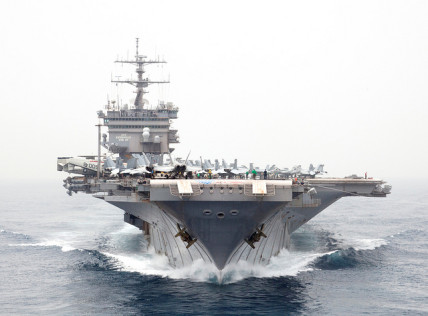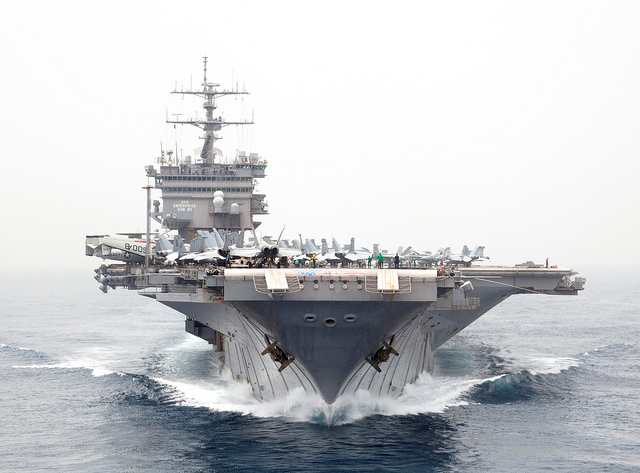
Photograph by Brooks B. Patton Jr/US Navy
The National Audit Office’s latest report tallies the cost of indecision underpinning the procurement of two aircraft carriers.
Last week, the National Audit Office (NAO) published a report analysing the costs accrued as a result of altering Labour’s plans for two ‘supercarriers’, first in 2010, and the subsequent about-turn in 2012. Readers may recall that as part of the 1998 Strategic Defence Review (SDR), New Labour responded to the agreed requirement that Britain should increase its global projection and mobile air power in the post-Cold War military environment.
Two Supercarriers were commissioned in 2007, HMS Queen Elizabeth and HMS Prince of Wales(both Queen Elizabeth-class aircraft carriers), with delivery dates set for 2014 and 2016 respectively. Each would weigh 65,000 tonnes and be capable of carrying up to forty aircraft of various types.
Following a prolonged comedy of errors underpinning the decision-making process and exponentially rising costs, it was decided by the Coalition in 2010 that savings had to be made. The Strategic Defence and Security Review (SDSR) advised that the traditional catapult method of launching aircraft from the deck should retroactively replace the original concept of accommodating for STOVL (Short-take off and vertical-landing), a system which would rely solely on the engines of the aircraft, like the famed Harrier Jump Jet.
However, in May 2012, the government was forced to make a humiliating retreat. Again, STOVL was officially backed as the best design option, largely because of spiralling deck-alteration costs, and criticism over the ‘practical limitations to the warfighting interoperability with allies’. The estimated drain of £7 billion was deemed wholly unacceptable, especially as the deck conversion alone was estimated at £2 billion.
The NAO points out in its report that the root of the carrier problems must be located in the October 2010 decision to scrap STOVL. It ‘was based on immature data and a number of flawed assumptions’ regarding the carrier variant of the Joint Strike Fighter (JSF), not least the fact that delivery would be delayed until 2020, and that the price of adopting an untested technology from the US would be manageable.
Whilst it concludes that the Ministry of Defence (MoD) ‘acted quickly to provide decision-makers with significantly improved information’ during the 2012 reversion process, the greatest risks to the Carrier Strike project possibly lie ahead. Most notably, the procurement of STOVL aircraft will result in a capability gap, particularly an inability to fully meet the Deep and Persistent Offensive Capability (DPOC) requirement underpinning the Royal Navy’s strategic aims. In comparison to STOVL, ‘the carrier variant has a greater range and payload and would provide a more effective strike capability’.
Equally concerning is the MoD’s indecision on the fate of HMS Prince of Wales, the second carrier; a judgment which will be stalled until the 2015 defence review. If the second is not brought into service by the Royal Navy, and instead sold, the operational capacity of Britain’s Carrier Strike will only reach 70 per cent, and greatly reduce the ‘persistent’ requirement of DPOC. With two functioning carriers, it would be possible to commit one to a strike whilst the other refuelled and rearmed.
Despite these policy setbacks, the evidence suggests that the MoD made the right choice. Although it ‘expects to write-off approximately £74 million’ as a result of work begun following the 2010 decision, it was able to prevent a further £123 million being needlessly sunk into the conversion, and over the next decade the STOVL option should prove to be £1.2 billion cheaper than the carrier variant. The NAO is sceptical that overall project costs will remain at the £5.46 billion promised by the MoD, but accepts that rises will be inevitable.
From a strategic perspective, Britain continues to face years without the unmatched power projection of aircraft carriers. Perhaps this is the real cost of Whitehall’s indecision. Even when they arrive in 2020, the ‘Crowsnest’ helicopter early warning system will not be available for a further two years, reducing operational effectiveness. If, as evidence suggests, Whitehall is engineering a new diplomatic bearing in the Gulf, then a policy of deterrence will have to rely on effective mediation and other, less overt military assets such as Destroyers and the threat of nuclear submarines.
The show of strength that an aircraft carrier provides cannot be understated and no doubt Downing Street will be grateful once Britain boasts the capability again. Judging by the NAO’s report, the MoD made the best of a bad situation and was able to save valuable defence funds before much was wasted. However, there is a lesson to be learnt about dealing with the ever-evolving defence procurement industry, and that choosing a capability before it becomes obsolete is a relentless challenge. Perhaps the Coalition felt that Labour had hurriedly opted for the ‘latest thing’ without proper statistical analysis or test data. Regardless, if spiralling contract costs and delayed delivery dates are the way of the future, then perhaps the proposed delegation of Defence Equipment & Support (DE&S) duties to a private company is courting potential disaster. It would be all too easy for the MoD to reform in haste, and repent at (expensive) leisure.
Written by Michael Jones





1 Comment
awesome